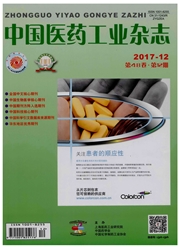

 中文摘要:
中文摘要:
将牛血清白蛋白(BSA)或BSA-锌复合物溶解或分散于聚L-丙交酯(PLLA)溶液中,再分别用乳化-溶剂蒸发法或凝胶模板法(聚乙烯醇模板)制备得到4种BSA-PLLA微粒,并表征其性能。结果表明,乳化-溶剂蒸发法所得的2种微粒(s/o/w和w/o/w微粒)和凝胶模板法所得的2种微粒(s/o/t和w/o/t微粒)平均粒径分别为38.13、34.65、49.47和45.82μm,跨距为0.77、0.86、0.22和0.26,包封率分别为15.62%、7.74%、85.87%和81.77%。前法制得的微粒包封率明显较低。体外释放试验中,上述4种微粒在d1的突释量分别为1.3%、13.3%、18.9%和55.7%,127 d的累积释放率为14.1%、83.6%、57.5%和60.6%。可见,制备方法会显著影响微粒的形态和结构,继而影响载药性能和释药特征。
 英文摘要:
英文摘要:
Bovine serum albumin (BSA) or BSA-Zn complex was dissolved or dispersed in poly (L-lactic acid) (PLLA) solution, which were further loaded into microparticles by emulsion-solvent evaporation method or hydrogel template technique (with polyvinyl alcohol as a template). Then four kinds of microparticles were obtained and their properties were characterized. The average particle size of the former two (named as s/o/w and w/o/w microparticles) and the last two (named as s/o/t and w/o/t microparticles) were 38.13, 34.65, 49.47 and 45.82 μm, the span values were 0.77, 0.86, 0.22 and 0.26, the entrapment efficiencies were 15.62% , 7.74%, 85.87% and 81.77%, respectively. The drugloading capacities of the two kinds of micropartieles prepared by the former method were significantly decreased. The results of in vitro release test showed that the burst release at the first day of the above four products were 1.3 %, 13.3 %, 18.9% and 55.7%, the cumulative release at 127 d were 14.1%, 83.6%, 57.5% and 60.6%0, respectively. It indicated that morphology and structure of microparticles significantly affected by the preparation methods, which further impacted drug-loading efficiency and release profile.
 同期刊论文项目
同期刊论文项目
 同项目期刊论文
同项目期刊论文
 期刊信息
期刊信息
